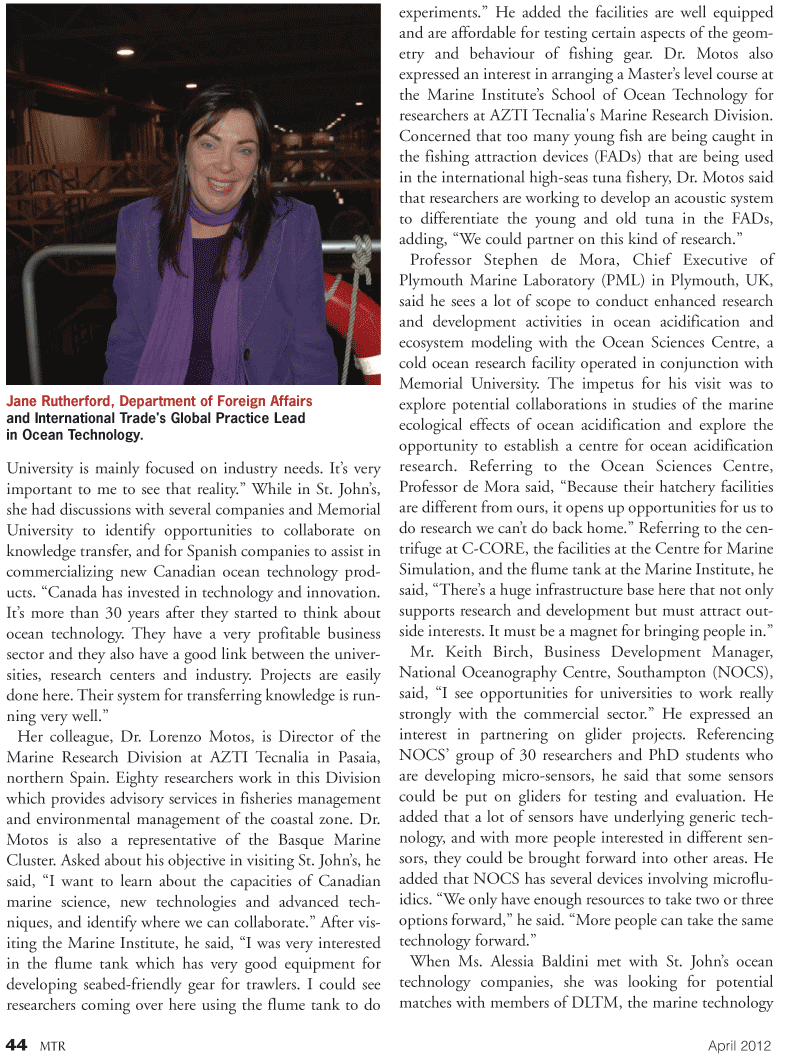
Page 44: of Marine Technology Magazine (April 2012)
Global Offshore Deepwater Report
Read this page in Pdf, Flash or Html5 edition of April 2012 Marine Technology Magazine
44MTRApril 2012University is mainly focused on industry needs. Its very important to me to see that reality.? While in St. Johns, she had discussions with several companies and Memorial University to identify opportunities to collaborate on knowledge transfer, and for Spanish companies to assist in commercializing new Canadian ocean technology prod- ucts. Canada has invested in technology and innovation. Its more than 30 years after they started to think about ocean technology. They have a very profitable business sector and they also have a good link between the univer- sities, research centers and industry. Projects are easily done here. Their system for transferring knowledge is run- ning very well.? Her colleague, Dr. Lorenzo Motos, is Director of the Marine Research Division at AZTI Tecnalia in Pasaia, northern Spain. Eighty researchers work in this Division which provides advisory services in fisheries management and environmental management of the coastal zone. Dr. Motos is also a representative of the Basque Marine Cluster. Asked about his objective in visiting St. Johns, he said, I want to learn about the capacities of Canadianmarine science, new technologies and advanced tech- niques, and identify where we can collaborate.? After vis- iting the Marine Institute, he said, I was very interested in the flume tank which has very good equipment for developing seabed-friendly gear for trawlers. I could see researchers coming over here using the flume tank to do experiments.? He added the facilities are well equipped and are affordable for testing certain aspects of the geom- etry and behaviour of fishing gear. Dr. Motos also expressed an interest in arranging a Masters level course at the Marine Institutes School of Ocean Technology for researchers at AZTI Tecnalia's Marine Research Division. Concerned that too many young fish are being caught in the fishing attraction devices (FADs) that are being used in the international high-seas tuna fishery, Dr. Motos said that researchers are working to develop an acoustic system to differentiate the young and old tuna in the FADs, adding, We could partner on this kind of research.? Professor Stephen de Mora, Chief Executive of Plymouth Marine Laboratory (PML) in Plymouth, UK, said he sees a lot of scope to conduct enhanced research and development activities in ocean acidification and ecosystem modeling with the Ocean Sciences Centre, a cold ocean research facility operated in conjunction with Memorial University. The impetus for his visit was to explore potential collaborations in studies of the marine ecological effects of ocean acidification and explore the opportunity to establish a centre for ocean acidification research. Referring to the Ocean Sciences Centre, Professor de Mora said, Because their hatchery facilities are different from ours, it opens up opportunities for us to do research we cant do back home.? Referring to the cen- trifuge at C-CORE, the facilities at the Centre for Marine Simulation, and the flume tank at the Marine Institute, he said, Theres a huge infrastructure base here that not only supports research and development but must attract out- side interests. It must be a magnet for bringing people in.? Mr. Keith Birch, Business Development Manager, National Oceanography Centre, Southampton (NOCS), said, I see opportunities for universities to work really strongly with the commercial sector.? He expressed an interest in partnering on glider projects. Referencing NOCS group of 30 researchers and PhD students who are developing micro-sensors, he said that some sensors could be put on gliders for testing and evaluation. He added that a lot of sensors have underlying generic tech- nology, and with more people interested in different sen- sors, they could be brought forward into other areas. He added that NOCS has several devices involving microflu- idics. We only have enough resources to take two or three options forward,? he said. More people can take the same technology forward.? When Ms. Alessia Baldini met with St. Johns ocean technology companies, she was looking for potentialmatches with members of DLTM, the marine technology Jane Rutherford, Department of Foreign Affairs and International Trade's Global Practice Lead in Ocean Technology.

 43
43

 45
45
